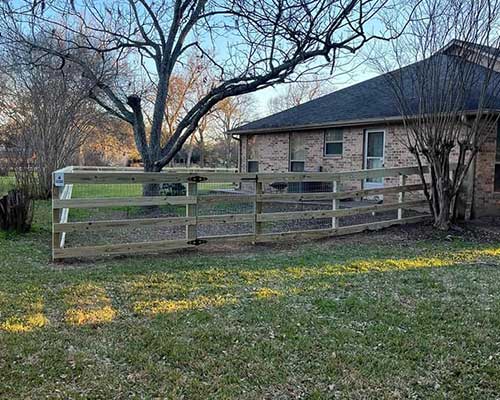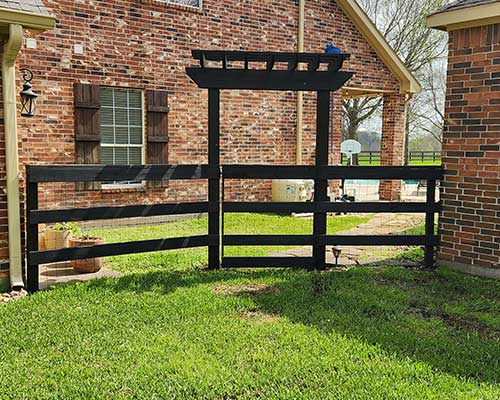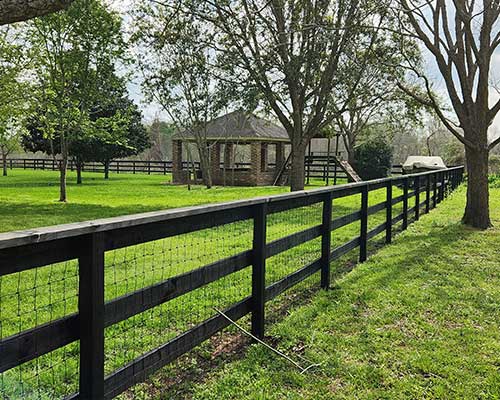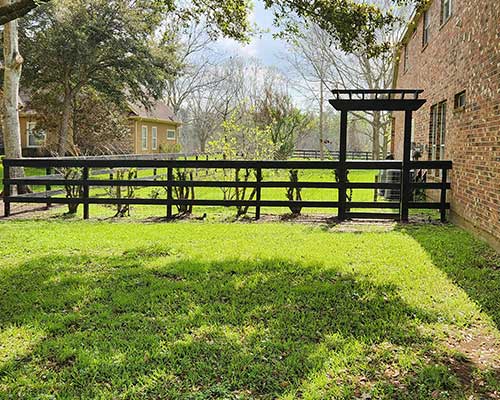Frequently Asked Questions
What materials are commonly used for corral fencing?
The materials commonly used for corral fencing include wood, metal, and vinyl. Each option offers unique benefits such as durability, aesthetic appeal, and low maintenance, making them suitable for various residential and agricultural applications.
Can I build a wood corral fence myself?
Building a wood corral fence yourself is possible if you have the necessary tools and skills. However, it’s important to consider the complexity and ensure proper installation for durability and effectiveness.
What is the cost of installing a wood corral fence?
The cost of installing a wood corral fence varies based on factors such as size, wood type, and labor. On average, you can expect to spend between $15 to $30 per linear foot for materials and installation.
Are wooden corral fences durable?
Wooden corral fences are known for their durability when constructed with high-quality wood and properly treated to resist weather and pests. With regular maintenance, they can last for many years while providing both functionality and aesthetic appeal.
How tall should a wood corral fence be?
The ideal height for a wood corral fence typically ranges from 4 to 6 feet, depending on the type of livestock being contained and the specific needs of your property.
What kind of warranty does Corral Fence Company offer?
The warranty offered by Hogue Fence Company ensures quality and durability, covering materials and workmanship for a specified period, providing peace of mind and confidence in your corral fencing investment.
Can a wood corral fence be stained or painted?
A wood corral fence can indeed be stained or painted. This not only enhances its aesthetic appeal but also provides additional protection against weathering and extends its lifespan.
How do I maintain a wood corral fence?
Maintaining a wood corral fence involves regular inspection for damage, cleaning to prevent debris buildup, and applying a protective sealant every few years to enhance durability. Additionally, touch-up painting may be necessary to preserve its aesthetic appeal.
How tall should a corral fence be for horses?
The ideal height for a corral fence for horses typically ranges from 4.5 to 5.5 feet. This height helps ensure the safety and security of the horses while preventing them from jumping over.
How do you install a corral fence post?
Installing a corral fence post involves digging a hole to the desired depth, inserting the post, ensuring it's level, and then backfilling the hole with soil or concrete for stability.
What type of wood is best for a corral fence?
The best type of wood for a corral fence is typically treated cedar or oak, as these species are known for their durability and resistance to decay, ensuring long-lasting performance in outdoor settings.
Can corral fences be used for cattle enclosures?
Corral fences are ideal for cattle enclosures, offering durability and safety. Constructed from high-quality materials, they provide secure containment, ensuring your cattle remain safe while also enhancing the overall aesthetics of your property.
What design options are available for corral fencing?
The available design options for corral fencing include traditional wooden posts, metal panels, wire fencing, and customized styles that enhance both functionality and aesthetics to suit your property's needs.
How can I improve the strength of my corral fence?
Improving the strength of your corral fence involves using high-quality materials, ensuring proper post spacing, reinforcing corners with braces, and maintaining regular inspections to address wear and tear.
What maintenance is required for wooden corral fences?
The maintenance required for wooden corral fences includes regular inspections for rot or damage, cleaning dirt and debris, and applying sealants or stains every few years to enhance durability and appearance.
Which wood is most suitable for corral fences?
The most suitable wood for corral fences is typically cedar or redwood due to their natural resistance to rot and insects, providing durability and longevity for both residential and agricultural settings.
What factors affect the cost of corral fencing?
The cost of corral fencing is influenced by several factors, including the type of materials used, the size of the area to be fenced, labor costs, and any custom features or designs required.
How can I enhance the appearance of my corral fence?
Enhancing the appearance of your corral fence can be achieved by choosing quality materials, opting for custom designs, and adding decorative elements like posts and caps. Additionally, regular maintenance, such as staining or painting, can elevate its visual appeal.
Is it possible to customize corral fence designs?
Customizing corral fence designs is indeed possible. Hogue Fence Company offers a variety of options to meet your specific aesthetic and functional needs, ensuring that your fencing solution perfectly complements your property.
What are the best practices for installing corral posts?
The best practices for installing corral posts include ensuring proper spacing, using durable materials, and setting posts deep enough for stability. Additionally, align posts vertically and check for level before securing to maintain a sturdy and visually appealing fence.
What features should I look for in corral fencing?
The features to look for in corral fencing include durability, resistance to weather and rot, customization options for various property styles, and safety for livestock. High-quality materials and secure installation are also essential for effectiveness.
How does weather impact wooden corral fences?
The impact of weather on wooden corral fences is significant. Extreme temperatures, moisture, and UV exposure can cause wood to warp, crack, or rot, necessitating regular maintenance and protective treatment to prolong their lifespan and stability.
Can I use recycled materials for corral fencing?
Recycled materials can be used for corral fencing. They offer an environmentally friendly option while maintaining durability and functionality, ensuring that your fencing solution remains effective and sustainable.
What safety considerations should I keep in mind for corral fences?
Safety considerations for corral fences include ensuring no sharp edges or protrusions, using durable, non-toxic materials, regularly inspecting for wear or damage, and ensuring proper height and visibility to prevent accidents with livestock and people.
How do I protect my corral fence from pests?
Protecting your corral fence from pests involves regular inspections, applying pest-resistant treatments, and maintaining proper drainage to prevent moisture buildup. Consider using natural repellents and ensuring surrounding vegetation is well-trimmed to deter infestations.
What are the signs of wear in wooden corral fences?
The signs of wear in wooden corral fences include visible cracks, warping, splintering, and discoloration. Additionally, loose or missing boards and signs of insect infestation can indicate deterioration, necessitating timely repairs to maintain security and appearance.
How long does it take to build a corral fence?
The time it takes to build a corral fence varies depending on factors like size, complexity, and terrain, but typically ranges from a few days to a week for standard installations.
Are there regulations for installing corral fences?
Regulations for installing corral fences exist and may vary by location. It’s essential to check local zoning laws and building codes to ensure compliance before installation.
What tools do I need for corral fence installation?
The tools needed for corral fence installation include a post hole digger, level, measuring tape, hammer, and fence staples. Additionally, a power drill and saw may be necessary for a more efficient installation process.
How can I ensure my corral fence lasts longer?
To ensure your corral fence lasts longer, regularly inspect for damage, treat wooden posts with preservatives, and maintain proper drainage to prevent rot. Additionally, choosing high-quality materials from Hogue Fence Company enhances durability and resilience against the elements.












